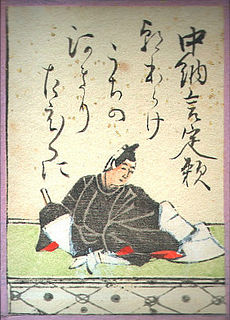 W
WAkazome Emon was a Japanese waka poet and early historian who lived in the mid-Heian period. She is a member both of the Thirty Six Elder Poetic Sages and the Thirty Six Female Poetic Sages .
 W
WDaini no Sanmi was a Japanese waka poet of the mid-Heian period.
 W
WFujiwara no Sadayori was a Japanese waka poet of the mid-Heian period. One of his poems was included in the Ogura Hyakunin Isshu. He produced a private collection.
 W
WFujiwara no Kintō , also known as Shijō-dainagon, was a Japanese poet, admired by his contemporaries and a court bureaucrat of the Heian period. His father was the regent Fujiwara no Yoritada and his son Fujiwara no Sadayori. An exemplary calligrapher and poet, he is mentioned in works by Murasaki Shikibu, Sei Shōnagon and in a number of other major chronicles and texts.
 W
WFujiwara no Michimasa was a mid-Heian period Imperial court noble and poet. He is included in the Hyakunin Isshu and was the nephew of Emperor Ichijo's wife, Empress Fujiwara no Teishi.
 W
WGyōson , also known as the Abbot of Byōdō-in , was a Japanese Tendai monk and waka poet of the late-Heian period. He became chief prelate of the Enryaku-ji temple in Kyoto, and one of his poems was included in the Ogura Hyakunin Isshu. Almost fifty of his poems were included in imperial anthologies, and he produced a private collection of poetry.
 W
WIse no Taifu (伊勢大輔), also known as Ise no Tayū or Ise no Ōsuke, was a Japanese poet active in the early 11th century.
 W
WIzumi Shikibu was a mid-Heian period Japanese poet. She is a member of the Thirty-six Medieval Poetry Immortals . She was the contemporary of Murasaki Shikibu, and Akazome Emon at the court of empress Joto Mon'in.
 W
WKoshikibu no Naishi was a Japanese waka poet of the early eleventh century. One of her poems was included in the Ogura Hyakunin Isshu.
 W
WMinamoto no Tsunenobu was a Japanese nobleman and waka poet in the Heian period. One of his poems is included in the Ogura Hyakunin Isshu, in which he is known as Dainagon Tsunenobu (大納言経信).
 W
WMurasaki Shikibu was a Japanese novelist, poet and lady-in-waiting at the Imperial court in the Heian period. She is best known as the author of The Tale of Genji, widely considered to be one of the world's first novels, written in Japanese between about 1000 and 1012. Murasaki Shikibu is a descriptive name; her personal name is unknown, but she may have been Fujiwara no Kaoriko , who was mentioned in a 1007 court diary as an imperial lady-in-waiting.
 W
WRyōzen was a Japanese waka poet of the mid-Heian period. One of his poems was included in the Ogura Hyakunin Isshu, and thirty-one of his poems were included in imperial anthologies from the Goshūi Wakashū on.
 W
WSagami , also known as Oto-jijū (乙侍従), was a Japanese waka poet of the mid-Heian period. One of her poems was included in the Ogura Hyakunin Isshu. She produced a private collection, the Sagami-shū.
 W
WSei Shōnagon was a Japanese author, poet, and a court lady who served the Empress Teishi (Sadako) around the year 1000 during the middle Heian period. She is the author of The Pillow Book .
 W
WSugawara no Takasue no musume , also known as Takasue's Daughter, was a Japanese noble woman, poet, and author best known for writing the Sarashina Nikki, a Heian period travel diary recording her life and travels from her teenage years to her fifties. She is also attributed by some scholars as the author of Hamamatsu Chūnagon Monogatari and Yoru no Nezame. Her personal name is unknown.
 W
WSuō no Naishi was a Japanese waka poet of the late-Heian period. One of her poems was included in the Ogura Hyakunin Isshu, and thirty-five in imperial collections. She also produced a private waka collection, the Suō no Naishi-shū.